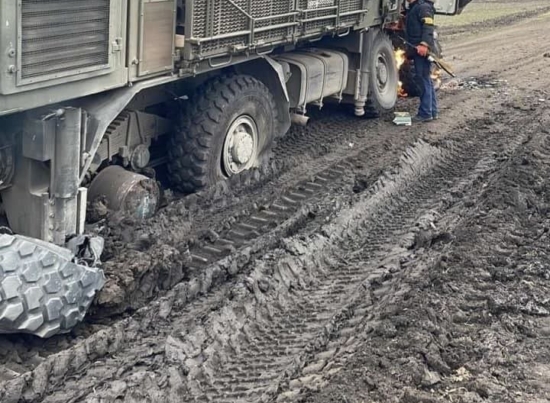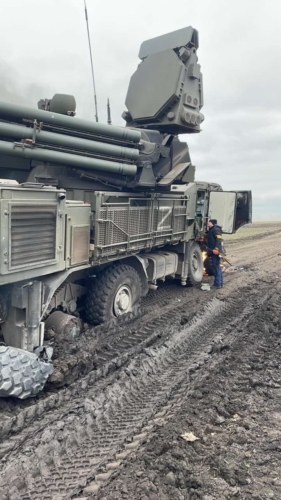Are tyre issues hampering Russian military progress in Ukraine?

The stricken Russian Pantsir-S1 missile system, missing its failed rear tyre (Photo taken from @TrentTelenko’s Twitter feed)
Tyres and poor vehicle maintenance could be contributing to the stalling Russian military effort north of Kyiv. The UK defence ministry has reported that Russia’s 40-mile military convoy in northern Ukraine has made no significant progress for several days, stalled on the roads leading into the Ukranian capital, Kyiv, and hampered by equipment malfunctions and improvised roadblocks. So why does the Russian military not simply forge off-road routes to aid progress? According to military history blogger and retired US Department of Defense civil servant Trent Telenko, the combination of Ukraine’s mud season, or “Rasputitsa” and the poor state of Russian military vehicles’ tyres make such moves extremely difficult to make.
Using videos and images of a Russian Pantsir-S1 missile system abandoned on a muddy track, and the vehicles parked on the tarmac road behind it to avoid taking the same route, Telenko suggests that “corrupt” maintenance practices have led to tyre sidewall degradation and failure under the stress of navigating muddy roads.
This is a thread that will explain the implied poor Russian Army truck maintenance practices based on this photo of a Pantsir-S1 wheeled gun-missile system’s right rear pair of tires below & the operational implications during the Ukrainian mud season.🧵
— Trent Telenko (@TrentTelenko) March 2, 2022
As he explains, it is important for tyres and vehicles’ central inflation systems to be “exercised” regularly. Similar advice exists for any vehicle, as Tyrepress readers will understand, though the stresses on these military radial tyres are of a different order, making this sort of maintenance all the more important. In the case of wheeled military machinery, which is often parked in open lots, preventative maintenance measures would include rotating the positioning of close-parked vehicles on around a monthly basis to give increased shade from the elements. Best practice would also mean running a cycle of the vehicle’s central inflation system – this would both flex the compound and ensure the system is functional.
Returning to the stricken Pantsir-S1, it is clear from the picture that a rear tyre has failed in the mud, detaching from the vehicle – another tyre also appears to have failed too. The tyre, which would have been run at low pressure to combat the mud, looks to have been unable to handle the increased flexion required of the sidewall with tears appearing and compromising the tyre’s inflation. The most likely reason for this in Telenko’s opinion would be poor maintenance – an opinion that seems very plausible. He reasons further: “If the Russian Army was too corrupt to exercise a Pantsir-S1… they were too corrupt to exercise the trucks & wheeled AFV’s now in Ukraine.”
Finally, another Twitter user responded to Telenko’s thread to suggest that the quality of the tyres fitted to Russian machinery could also be a contributory factor in the mobility difficulties they are currently experiencing. Self-identified “tire expert” and military advisor Karl T Muth suggests that the tyres fitted to the stricken Pantsir-S1 are manufactured by the Chinese Yellow Sea brand:
Bit of a tire expert here. Those aren’t Soviet-era heavy truck radials. Chinese military tires, and I believe specifically the Yellow Sea YS20. This is a tire I first encountered in Somalia and Sudan; it’s a bad Chinese copy of the excellent Michelin XZL military tire design. 🇫🇷
— Karl T. Muth 🌐✈️📊 (@KarlMuth) March 3, 2022
Add all this to this the well-documented supply chain issues the Russian military is experiencing and the slim chances of getting enough new tyres to the front quickly, and it appears that the Russians are, for the remainder of the Rasputitsa in this part of Ukraine at least, road bound.



Comments